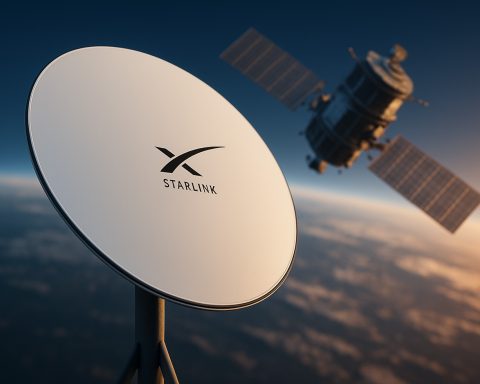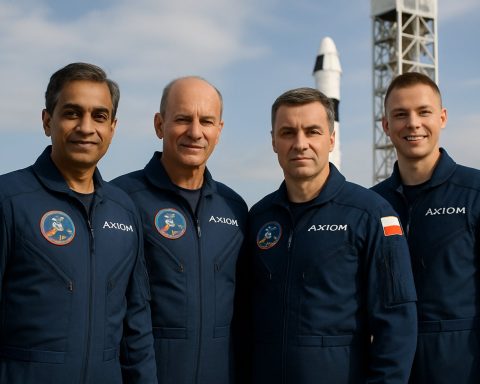- SpaceX’s Starship, consisting of a Super Heavy rocket and an upper stage, is poised for a potential orbital flight from South Texas, signaling a significant moment for humanity’s aspirations in space.
- The recent firing of the Starship’s Raptor engines in Boca Chica indicates readiness for the next phase of testing, aiming for a stable orbit.
- SpaceX’s journey has faced challenges, including fiery test failures, highlighting a narrative of resilience and ambition.
- Elon Musk envisions interplanetary travel, particularly targeting Mars expeditions by the end of 2026.
- With essential FAA approvals for expanded testing, SpaceX can now conduct 25 annual launches, facilitating rapid innovation.
- Starship represents a transformative step in space exploration, from Earth-bound dreams to tangible actions toward the stars.
The anticipation is palpable along the South Texas coastline, as Elon Musk’s SpaceX prepares for the potential ascent of its Starship vehicle. This ambitious flight is not just a test—it’s a declaration of intent for humanity’s future in space. Towering over the flatland with its gleaming silver facade, the Starship, composed of a 232-foot Super Heavy rocket and a 171-foot upper stage, stands ready to push the limits of what’s possible.
In recent weeks, the faint rumble of powerful engines reverberated through Boca Chica when SpaceX fired the upper stage’s six Raptor engines, signaling its readiness for the challenges ahead. As the suspense builds, all eyes are on whether this colossal creation will finally achieve a stable trajectory into Earth’s orbit—a milestone it has tantalizingly brushed against in its previous endeavors.
This isn’t merely about testing technology; it’s a narrative of resilience and ambition. The road to this point has been marked by fiery explosions and instances where the majestic machine fractured mid-air, scattering debris under the wide Texan sky. Yet, even these setbacks underscore SpaceX’s relentless pursuit. Each attempted flight presents invaluable lessons.
Through this relentless drive, SpaceX aims to redefine interplanetary travel. While the immediate objective is to perfect this behemoth’s orbital capabilities, the ultimate vision is even loftier: Mars. Elon Musk envisions a future where humanity expands its habitat beyond Earth, potentially launching the first Starship missions to the Red Planet by the end of 2026.
But the path to the cosmos is strewn with regulatory barriers, as much as technological ones. Just this month, SpaceX secured essential approvals from the Federal Aviation Administration to ramp up testing, granting them permission for 25 launches annually—up from last year’s modest four. This expansion is pivotal, providing the leeway to innovate rapidly and safely.
Courageously poised to leave a mark on space exploration history, Starship symbolizes not just an evolution of spacecraft but a seismic shift in human perspective—a move from dreaming to doing, from Earth to the stars. As the impending launch approaches, it’s a call to watch, to wonder, and to believe in a future where even the sky isn’t the limit. Will this next chapter in SpaceX’s story finally solidify its steps toward Mars? Only time will tell. But one thing is certain: we’re witnessing the dawn of a new era in space exploration.
The Unstoppable Journey of SpaceX’s Starship: Everything You Need to Know
The Ambition Behind SpaceX’s Starship
SpaceX’s Starship program is not just about crossing new technological frontiers; it represents a fundamental shift in how humanity conceptualizes and approaches space exploration. At the heart of this initiative is the Starship vehicle, a towering feat of engineering composed of a 232-foot Super Heavy rocket and a 171-foot upper stage, designed to propel humankind into a future where interplanetary travel becomes a reality.
Key Features and Specs
– Height: The Starship combined with its Super Heavy booster stands at a staggering 394 feet.
– Engine: Equipped with Raptor engines using cryogenic methane and oxygen as fuel, a first in reusable rocket technology.
– Payload Capacity: Starship is designed to carry over 100 metric tons into orbit, setting a new bar for launch vehicles.
– Reusability: The focus on full reusability aims to drastically reduce costs, making space more accessible.
Overcoming Challenges
SpaceX has faced numerous hurdles on the path to perfecting the Starship, with multiple test flights ending in failures. However, these failures have been embraced as learning opportunities, fueling innovations and improvements. These setbacks, while costly, underscore SpaceX’s resilience and commitment to developing a robust and reliable vehicle capable of orbital flight.
Regulatory Landscape and Market Forecast
SpaceX recently received vital approvals from the Federal Aviation Administration (FAA) to increase its launch frequency, going from four to 25 launches annually. This regulatory flexibility is crucial, providing the company with the operational scope needed to refine the Starship’s capabilities swiftly and responsibly.
As space exploration continues to open up to commercial ventures, the market for satellite deployment, space tourism, and interplanetary transport is set to grow exponentially. SpaceX stands poised to capture a significant share of this burgeoning market, paving the way for new partnerships and opportunities.
Real-World Use Cases and Future Prospects
1. Satellite Deployment: Starship can deploy large payloads, providing cost-effective options for commercial and governmental space missions.
2. International Lunar Missions: The vehicle is capable of delivering payloads and potentially crewed missions to the Moon, supporting NASA’s Artemis program.
3. Mars Colonization: Elon Musk’s vision of establishing a human settlement on Mars by the end of the decade is ambitious but not outside the realm of possibility given SpaceX’s trajectory.
Pros and Cons Overview
Pros:
– High payload capacity
– Fully reusable system reducing costs
– Pioneering methane-fueled rocket engines
Cons:
– Significant technical and regulatory challenges
– High cost of development
– Risk of mission failure during early tests
Essential Considerations and Quick Tips
– Investing in SpaceX: While SpaceX is a private company, investors can look into mutual funds or stocks of public companies collaborating with SpaceX.
– Staying Informed: Follow credible sources like NASA and official SpaceX communications for updates on test launches and technological advances.
– Educational Opportunities: Explore programs and courses in aerospace engineering or space sciences to understand the future workforce demands in space exploration.
Conclusion
SpaceX’s Starship is on the brink of revolutionizing how we approach space travel—fulfilling dreams of interplanetary exploration and commerce. As technical barriers diminish and regulatory frameworks grow increasingly supportive, the potential for human expansion into the solar system becomes an exciting and attainable frontier. As you follow SpaceX’s journey, consider how these developments might change not just the way we perceive space, but our place within it.
Stay tuned to their progress and the advancements in aerospace innovation, which promise to bring the universe closer to home.







